
Crucial MX500 SSD Review: The New Go-To Drive For System Builds
Introduction

Crucial has two consumer SSD lines, the BX series which is their entry-level line and the MX series which is their mainstream line. The BX line is a stripped down version of the MX that does not have features like hardware encryption or dynamic write acceleration. Now, since the BX series is their entry-level line, you would think that Crucial would use TLC flash to keep the cost down and use MLC flash on their MX series but that's not the case here. Entry-level SSDs typically utilize TLC flash because it is cheaper but a couple of months ago, Micron released the Crucial BX300 which utilizes MLC flash and offers excellent performance at an affordable price and it even outperforms its MX series.
Recently, Crucial expanded its MX line with the addition of the MX500 SSD which is the successor to the Crucial MX300 that was released about a year and a half ago. The MX500 series range in capacities of 250GB, 500GB, 1TB and 2TB, and come in two form factors: either 2.5” or M.2 but the 2TB version is for the 2.5” form factor only.
Crucial has released the pricing and specifications of all of their MX500 models and today we are reviewing the MX500 1TB and 500GB models which retail for $260 and $140, respectively. The other models come in at $80 for the 250GB and $500 for the 2TB model and they all feature a five-year limited warranty.
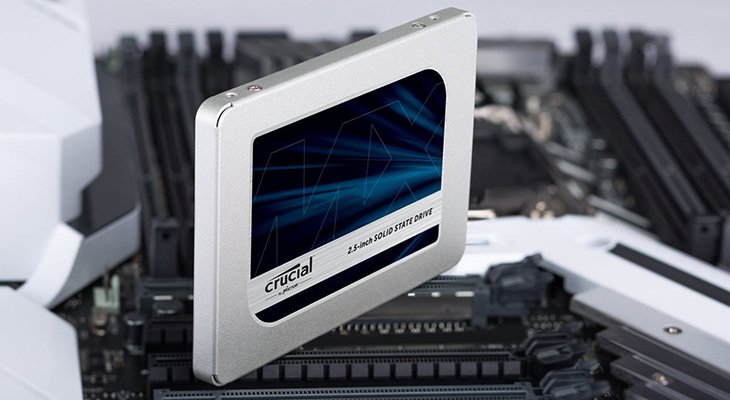
The MX500 comes with Micron's new 64-layer 3D TLC NAND and utilizes the Silicon Motion SM2258 four-channel controller backed by Micron's low-power DDR3 memory. Crucial advertises the MX500 series with sequential read speeds of up to 560 MB/s and sequential write speeds of up to 510 MB/s for all capacities. Random 4K write speeds for all capacities is rated for up to 90K IOPS and 95K IOPS for random 4K read speeds.
Pricing & Endurance
Crucial's 3D-NAND technology is built to endure 100TB (TBW) which equals to about 54GB per day for 5 years for the 250GB model. The 500GB model can handle up to 180TB (TBW) and 360TB (TBW) for the 1TB model. This equates to 98GB daily read/write for the 500GB model and 197GB for the 1TB model for 5 years. The 2TB model on the other hand can endure up to 700TB (TBW) which equals to about 383GB per day for 5 years.
The main competitor of the Crucial MX500 is the Samsung 850 EVO which is why Crucial has increased their warranty from 3 years to 5 years to match that of the 850 EVO. Price-wise, the MX500 series are significantly less expensive than the Samsung 850 EVO series. The MX500 1TB is about $40 less than the 850 EVO 1TB while the MX500 500GB is roughly $10 cheaper compared to the 850 EVO 500GB.
Not only is Micron beating Samsung in price, but in write endurance too. Samsung's 850 EVO 1TB/500GB can only endure 150TB TBW (Terabytes Written) while the MX500 1TB more than doubles that with up to 360TB TBW. Even the MX500 500GB beats the 850 EVO 1TB in write endurance with up to 180TB (TBW). The difference in write endurance increases even more if we compare the 2TB model. So we are looking at up to 700TB for the MX500 2TB compared to 300TB for the 850 EVO 2TB.
Features
The MX500 supports many advance features such as Thermal Monitoring technology which dynamically adjusts storage component activity to help keep your system cool and minimizes the risk of damage caused by overheating. It also supports Self Monitoring and Reporting Technology (SMART) which basically is a monitoring system used to perform an analysis of the drive for problems with the intent of anticipating hardware failures.
Most SSDs utilize SLC Write Cache to boost write performance which is normally a fixed SLC cache size but the MX500 uses Dynamic Write Acceleration (DWA) which dynamically shrinks or grows the SLC cache size depending on the amount of data stored on the flash.
The Silicon Motion SM2258 controller comes with support for Opal/TCG encryption which you can use to keep your personal files and confidential data restricted from hackers and thieves with AES 256-bit encryption. It also supports a new feature called Power-Loss Immunity which is a built-in feature of the NAND that protects your data if your system suddenly shuts down.
These are all the advanced features the MX500 supports:
- Dynamic Write Acceleration
- Redundant Array of Independent NAND (RAIN)
- Multistep Data Integrity Algorithm
- Adaptive Thermal Protection
- Active Garbage Collection
- TRIM Support
- Self-Monitoring and Reporting Technology (SMART)
- Error Correction Code (ECC)
- Device Sleep Support
Specifications
| Crucial MX500 Series Lineup | ||||
|---|---|---|---|---|
| Model | MX500 250GB | MX500 500GB | MX500 1TB | MX500 2TB | Price | $79.99 | $139.99 | $259.99 | $499.99 |
| Interface | SATA III 6Gb/s | |||
| Protocol | AHCI | |||
| Form Factor | 2.5" 7mm | |||
| Controller | Silicon Motion SM2258 | |||
| DRAM | 256MB DDR3 | 512MB DDR3 | 1GB DDR3 | 2GB DDR3 |
| NAND | Micron 256Gb 64-layer 3D TLC | |||
| Sequential Read | 560 MB/s | |||
| Sequential Write | 510 MB/s | |||
| 4KB Random Read | 95K IOPS | |||
| 4KB Random Write | 90K IOPS | |||
| Endurance | 100 TB TBW | 180 TB TBW | 360 TB TBW | 700 TB TBW |
| Operating Temperature | 0°C to 70°C | |||
| Life Expectancy | 1.8 Million Hours | |||
| Device Sleep Typical | 2 mW | |||
| Idle Average | 55 mW | 65 mW | 110 mW | |
| Active Average | 70 mW | 75 mW | 150 mW | |
| Max Power | 3.5 W | 4.5 W | 5.0 W | |
| Dynamic Write Acceleration | Yes | |||
| TRIM supported | Yes | |||
| Encryption | Yes | |||
| Firmware | M3CR010 | |||
| Warranty | 5 Years | |||
| Launch Date | January 2018 | |||
Packaging
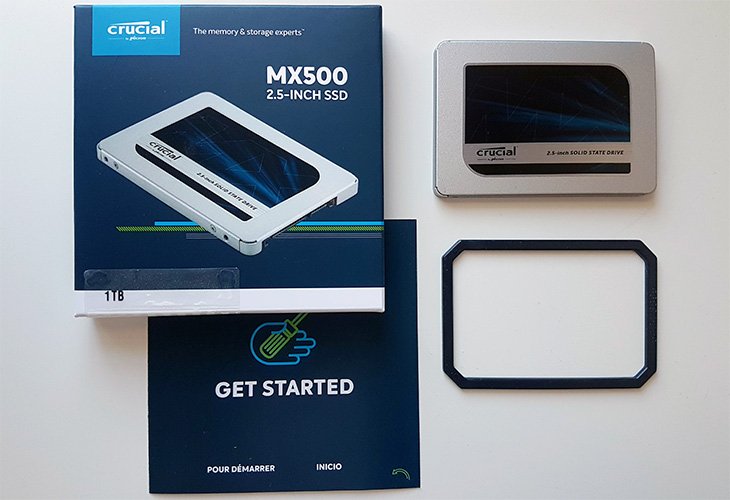
Crucial's MX500 packaging remains the same as their previous SSD packaging. The MX500 SSD comes in a silver aluminum enclosure and features the standard SATA III interface. Crucial includes the Acronis True Image HD software for transferring data from your old drive to your new MX500 SSD which can be redeemed online and they also include a 7mm to 9.5mm drive spacer to help fit the SSD in notebooks. Like most SSDs, the MX500 utilizes the SATA III 6Gbps interface but it is compatible with SATA II and SATA I interfaces, but that means it will work at a reduced speed.
You can download the Crucial Storage Executive software which helps enhance the performance of your SSD by allowing you to update the firmware, over-provision, and secure-erase the SSD. You can also monitor your SSD’s temperature, health, and track how much storage you’ve used. When you are inside the Storage Executive software, make sure to enable the Momentum Cache feature to instantly improve burst performance. Momentum Cache is not restricted by SATA bus throughput limitations but instead it uses additional DRAM bandwidth to achieve increased burst performance.
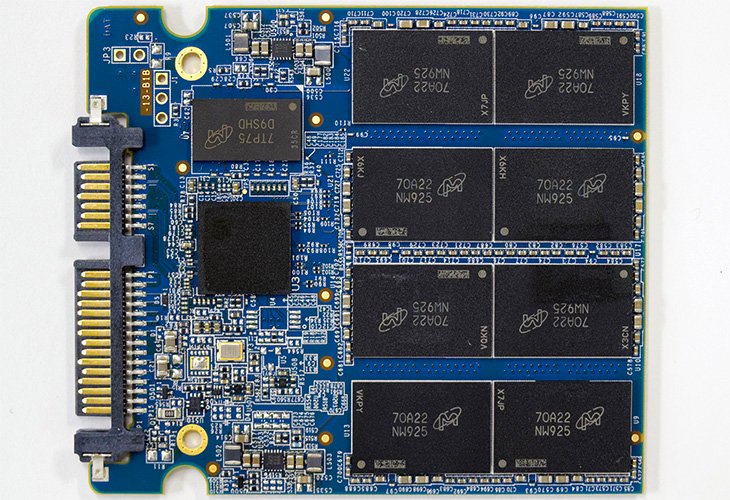
Above you will see a picture of the internals of the MX500 1TB model. There are a total of sixteen NAND flash memories, with eight on each side of the PCB which are produced by Micron and are built on a 16nm 3D NAND process. On one of the sides, you will find the Silicon Motion SM2258 4-channel controller and a DRAM chip next to it which basically provides the SSD controller with RAM. The 250GB/500GB models get 256MB and 512MB DRAM cache buffer while the bigger 1TB and 2TB models come with 1GB and 2GB DRAM cache buffer, respectively.
Test Methodology
| Test Setup | |
|---|---|
| Processor: | AMD Ryzen 7 1700X (3.8Ghz) |
| Motherboard: | MSI X370 xPower Titanium (BIOS v1.9) |
| RAM: | Ballistix Elite 16GB (2x8GB) DDR4 3200 MHz |
| Graphics Card: | Nvidia GeForce GTX 1070 |
| Storage: | Crucial MX500 1TB Crucial MX500 500GB Crucial BX300 240GB Crucial BX300 480GB Crucial MX300 525GB Crucial MX300 1TB Toshiba TR200 480GB Samsung 850 EVO 500GB Samsung 850 EVO 250GB Samsung 850 Pro 512GB |
| Power Supply: | Seasonic Focus Plus 750W Gold |
| Heatsink: | Noctua NH-D15 |
| OS: | Windows 10 Pro 64-Bit |
| Thermal Compound: | Noctua NT-H1 |
| Case: | Corsair 400C |
To make sure these drives perform at their maximum performance, we will be disabling all the power saving features in the BIOS (C6-state, etc). The testing was done on a fresh install of Windows 10 64-bit with the latest windows updates installed. We disabled a bunch of unnecessary services such as drive indexing, Prefetch, Superfetch, Defrag and removed all the bloatware from Windows 10 to make sure there were as few processes running as possible during the testing.
We'll be using the AMD Ryzen 7 1700X processor overclocked to 3.8Ghz and the MSI X370 xPower Titanium motherboard
with the latest BIOS version which at the time of writing this is v1.90.
Installing and using an SSD is pretty straight forward, simply connect one end of your SATA cable to the SATA port in your motherboard and the other end of the cable to your SSD.
After installing windows, make sure to check if you have the latest firmware.
Benchmark Software:
+ Windows 10 Startup
+ Adobe PS CS6 Startup
+ AS SSD
+ IOMeter
+ HD Tune Pro
+ ISO File Copy
Benchmark Results
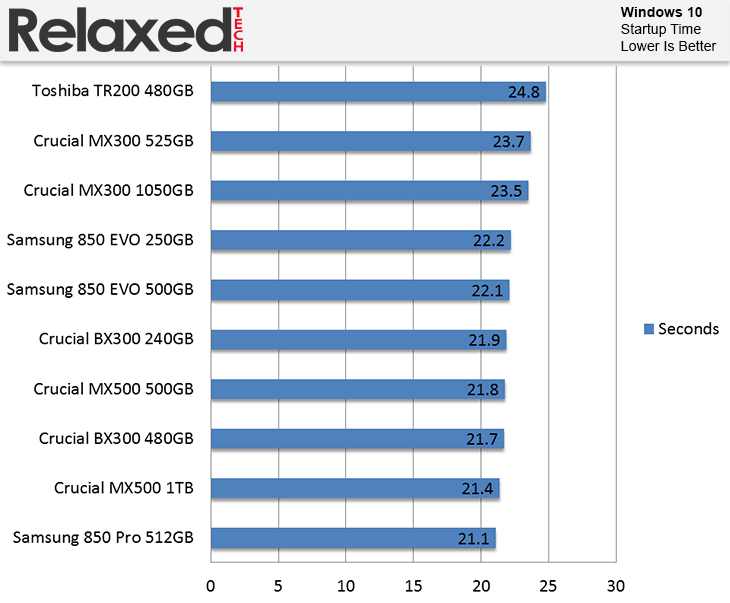
Windows 10 boot times are measured from the time it takes between hitting the power button to reaching the Windows desktop.
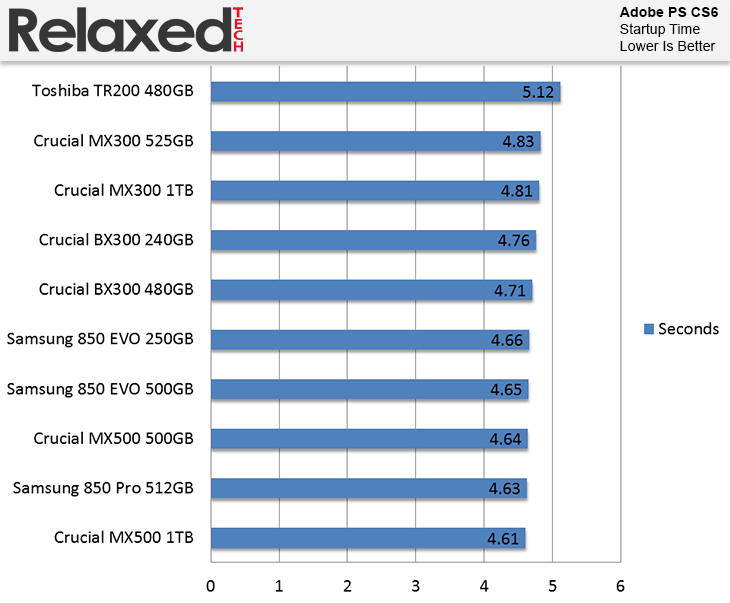
Startup times for Adobe Photoshop CS6 are measured from the moment it takes to open up the application.
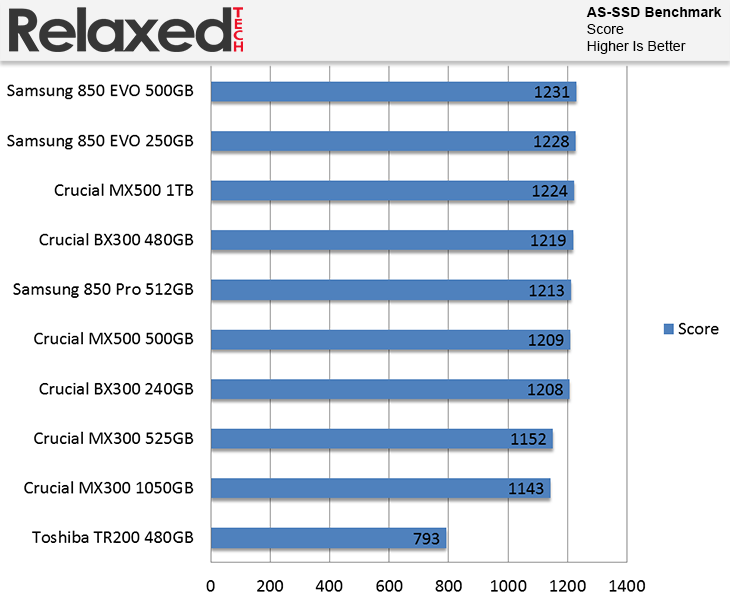
The AS-SSD software is a popular benchmarking software used to measure the performance of an SSD. In this test we are measuring the overall score.
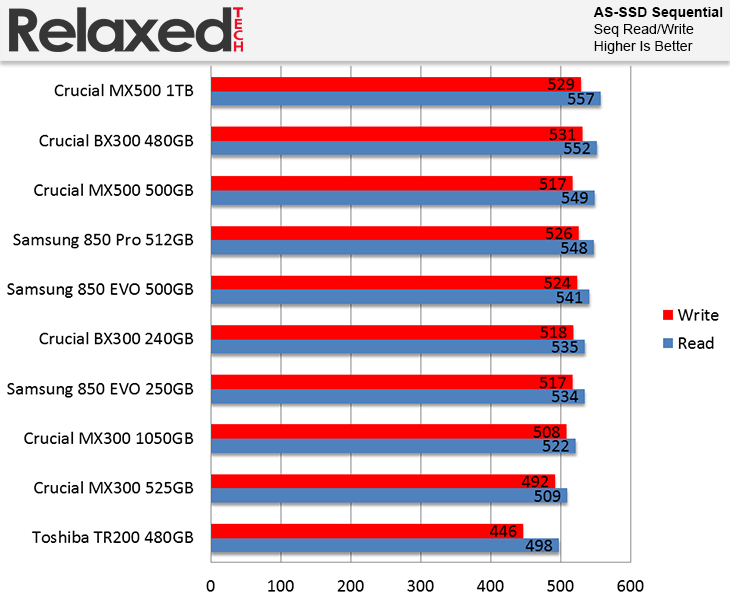
Once again, we are using the AS-SSD software to measure sequential read and write speed of each drive.
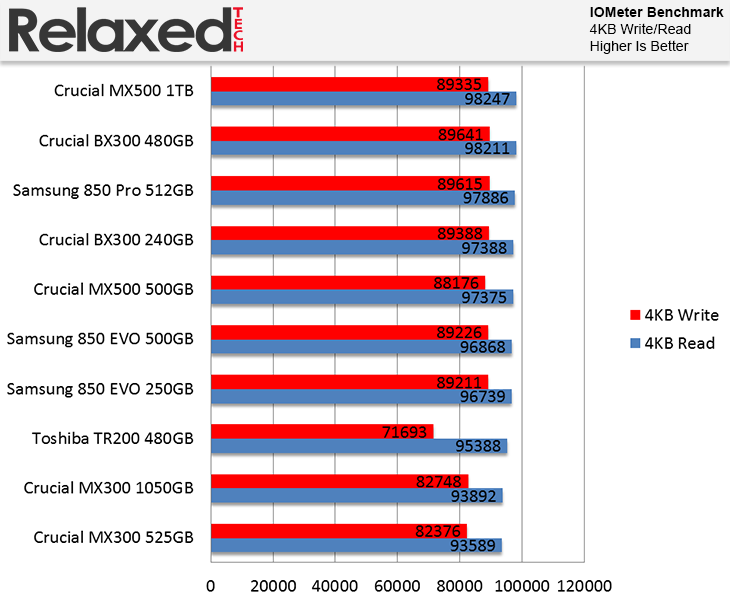
In this test, we are using IOMeter which is one of the best application for stress testing the random IO performance of an SSD. IOMeter is set to use 4KB file size chunks and will stress the SSD with random 4 KB files.
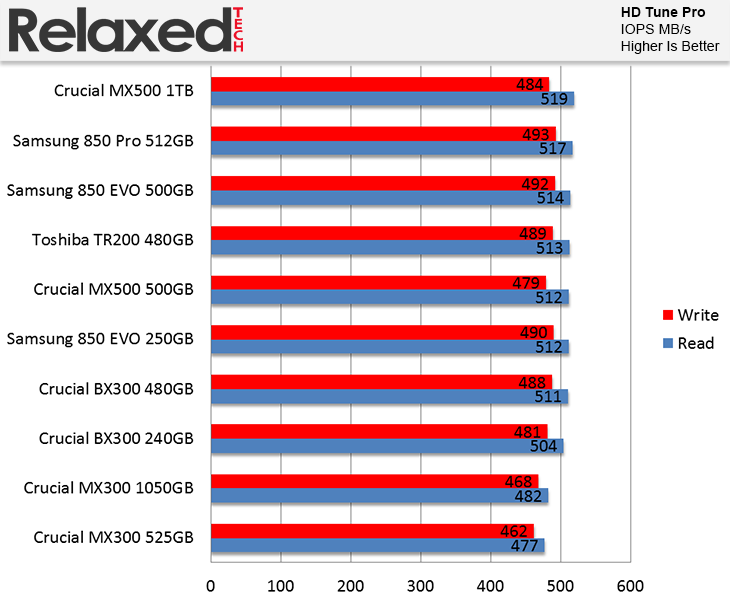
Here we are using HD Tune Pro to measure read and write IOPS. HD Tune Pro is a Hard Disk Utility with many functions such as error checking, S.M.A.R.T and benchmarking.
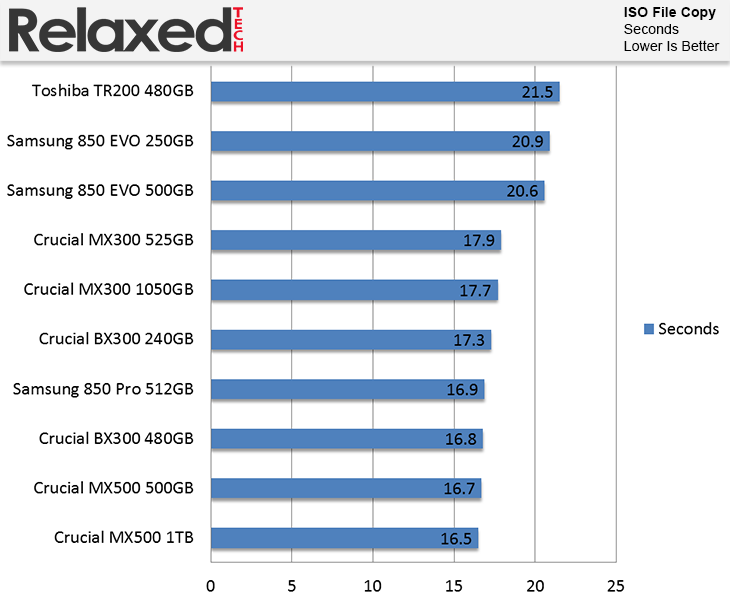
To represent a large file usage scenario, we are copying a 5GB ISO image to a different folder on the same drive.
Conclusion
Crucial has created a fantastic product with the MX500 SSDs.
The MX500 series come loaded with features such as hardware encryption, dynamic write acceleration, and can
also protect your data in case of a power outage.
Price-wise, the MX500 SSDs are hard to beat and offer more performance per dollar compared against the Samsung 850 EVO SSDs.
If you are using a traditional hard drive, definitely consider upgrading to an SSD like the MX500 because it will offer a massive
upgrade in every aspect from read/write speeds to access times.
Pros:
+ Outstanding Performance
+ Includes 7mm to 9.5mm Spacer
+ Acronis True Image HD Included
+ Higher Write Endurance Than Competition
+ Much Cheaper Than Competition
+ Hardware Encryption
+ Five-Years Warranty
Cons:
- None
I can't think of any downsides that I see with the MX500 1TB and 500GB SSDs because
it has everything you can want in a premium SSD, high performance at an affordable price.
Compared to the Samsung 850 EVO 1TB that retails for $300, the MX500 1TB is not only $40 cheaper but
it also has a significantly higher write endurance too. The MX500 500GB is also a much better product than the 850 EVO 500GB.
So if you're looking to buy the best SATA SSD on the market in 2018, the new Crucial MX500 drives are what you should be looking at. Also, Crucial ships their MX500 SSDs with the Acronis True HD Image software that can come in handy if you want to clone your drive. Overall, I believe the Crucial MX500 1TB and 500GB SSDs easily deserve our Elite award.
Final Score 10
